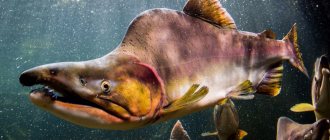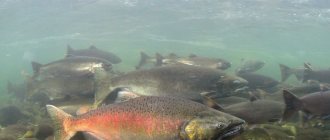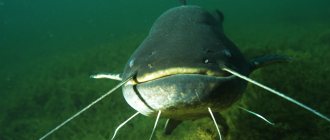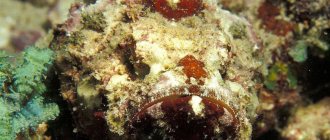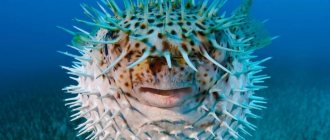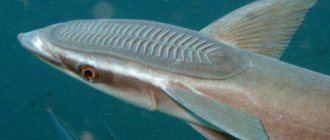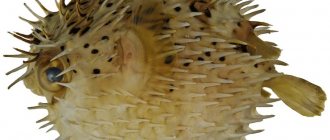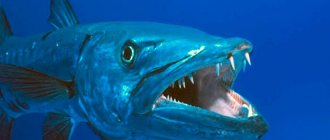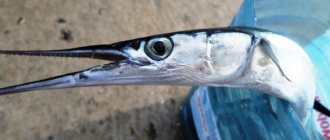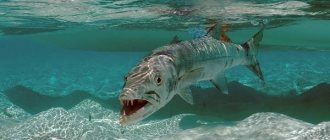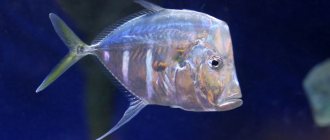- Wild animals
- >>
- Fish
Fugu fish is one of the most dangerous delicacies and the most poisonous fish in the world, which gourmets from all over the world dream of trying. Many are willing to pay a hefty sum in order to enjoy this delicacy and feel the fine line between life and death. Only professional chefs are involved in its preparation, since any mistake can lead to the most dire consequences.
Description and origin of the species
Fugu prefers to swim along the bottom.
Initially, the fish had the name “brown rockfish,” but the dish prepared from it, “fugu,” became so popular that it gradually began to be associated with this underwater inhabitant. The species belongs to the pufferfish and belongs to the genus Takifugu. The latter is divided into 26 subfamilies.
It is not known exactly when the first puffer fish appeared.
The oldest remains found so far are more than 12 thousand years old. The first mention of the creature is found in Japanese sources written in the 720s. Interesting fact : after a large-scale poisoning in the 1500s, cooking fugu was banned in Japan. It was allowed to be used for food only 200 years later.
A little history
In different countries this fish is called differently: in England - spherical or balloon fish, in Spain - boteta, in the Hawaiian Islands - maki-maki, and in Japan the most famous fish is fugu.
This fish has been known for quite a long time. Mention of it was found in Ancient Egypt: one of the drawings found on the tomb of the pharaoh of the Ti dynasty was very reminiscent of a fugue. At the same time, eastern sages wrote in their chronicles about its terrible poison. The very first Chinese medical “Book of Herbs”, written around the third millennium BC, also contains information about puffer fish.
In Japan it has been known and appreciated for a very long time, but in Europe it became known in the 17th century, thanks to trade relations with eastern countries. The Dutch physician Engelbert Kaempfer, while in Japan at the end of the 17th century, mentioned that some fish, when consumed, contain a lethal dose of poison, but this does not prevent the Japanese from eating it, throwing out the entrails and thoroughly washing the meat. He also talked about how Japanese soldiers were subject to serious sanctions for eating this fish. If one of the warriors died from fugu poisoning, then his son lost all the rights and privileges of his father entitled to him by law.
The famous captain James Cook also suffered from this fish. During his trip around the world, he landed on one of the islands, where one of the crew members exchanged a strange unknown fish from a native. It was decided to cook it for dinner. By this time, two guests were invited to the ship, who were supposed to describe and sketch the find. This took quite a long time, so the captain and the guests barely touched the food they served. They were incredibly lucky, since they served the liver and caviar of puffer fish, which contain a colossal amount of tetrodotoxin. The sailors escaped with a slight fright: weakness, loss of consciousness, slight numbness of the limbs. But one of the crew members who ate the entrails was not so lucky. In the morning he was found dead.
By the way, not so long ago in Japan there was an old unspoken law, the essence of which was that the cook who prepared the dish and poisoned the visitor was obliged to eat it himself or commit ritual suicide - the so-called seppuku or hara-kiri.
Appearance and features
Appearance of fugu fish
Appearance of fugu fish
Appearance of fugu fish
Appearance of fugu fish
Appearance of fugu fish
The color of the fish is brown, but may contain stripes and spots of gray and black. The eyes are small, but the fugu has excellent vision, as well as a sense of smell. This allows her to quickly navigate space and find food. Teeth stick out in the mouth, which tend to grow together. The fish has no scales. Instead, the fugu has needles all over its surface, which in the initial state are adjacent to it.
Fugu contains large amounts of tetrodotoxin. Thanks to him, the fish is the most poisonous in the world. If a person does not receive medical assistance in the first half hour after poisoning, then the worst consequences may occur for him. Interestingly, fugu does not produce poison on its own. It enters the body along with Pseudomonas bacteria during food intake. That is why tetrodotoxin is contained in fish meat, and does not accumulate on its surface.
Interesting fact : if the fugu does not get into the body of bacteria that secrete a toxin, then the fish will no longer be poisonous.
What does it taste like
The Japanese themselves describe the taste as “umami” and “kokumi”, which translated means “dense, rich” and “pleasant”.
The meat of the brown rocktooth tastes more like chicken than the fish familiar to many. However, even fried fillets lack the long, coarse fibers found in chicken. It's airy. When fresh, these are the thinnest pieces of fish that melt in your mouth, similar to dense jelly.
The taste and consistency may vaguely resemble squid. This dish does not need to be chewed at all; it dissolves itself in the mouth. The taste characteristic of seafood is very weak, it is felt only when the pieces of sashimi are properly cut and cut; the addition of sauces or spices can completely drown it out. Because of this characteristic of the brown rocktooth, it is recommended to first try clean pieces of fillet, and only then add soy or any other sauce. This is the only way to experience the full range of flavors of such a rare delicacy.
In the form of soup, the meat is enriched with added spices and related products without losing the faint sea flavor.
A special art is cutting the poisonous fugu fish in such a way that part of the poison gets into the meat. In addition to the fish’s own taste, when eating it, you also feel numbness in the mouth due to the action of the poison. The fish is very dangerous and you can easily get poisoned by it. Therefore, just anyone is not assigned to cook it.
There are special courses in Japan where chefs are taught all the intricacies of handling seafood. There are cases when people were poisoned by fish, ignoring safety precautions and trying to cook the fish with their own hands. In Japan and some other Pacific countries, there has long been a certain culture of preparing this fish. The Japanese, who are literally obsessed with seafood, preserve these traditions especially carefully.
Habitat - where it lives
Fugu prefer to live on the bottom.
Fugu lives on the bottom of oceans and seas, mainly swims at a depth of about 100 m. There it looks for food and feels great in the surrounding conditions. Most of the fish population is concentrated in the Pacific Northwest. It is also found in the Sea of Okhotsk and Sea of Japan.
Interesting fact : some species of fugu live in fresh waters. Fishermen catch them in the Nile, Amazon, Kogo and even Lake Chad.
Sometimes fugu is found near Peter the Great Bay and in Japanese reservoirs located close to Russia. In search of food, young individuals can live in the mouths of rivers, and the fry prefer less salty water. But as the fish grows, they still move to the seas and oceans.
Interesting: Sharks - description, types, what they eat, features, how long they live, where they live, photos and videos
Fugu fish: description
Poisonous representatives of the pufferfish family are distinguished by the fact that they have other names. For example:
- Clifftoothed teeth, in which the teeth are fused together and present a monolithic structure.
- Four-toothed or four-toothed, in which the teeth on the jaws are fused and form two upper and two lower plates.
- Dog fish with a well-developed sense of smell, and they are able to detect odors in the water column at a considerable distance.
For the Japanese, takifugu fish occupies a certain place in Japanese culture, and in Eastern culture in general. Fish poison affects living beings, leading to muscle paralysis. In this case, a living being retains purity of consciousness until the moment of death. Death occurs as a result of suffocation. There is currently no antidote to the poison of fugue fish, so doctors, in case of poisoning, simply support the functioning of the human respiratory and circulatory system until the effect of the poison completely stops.
Interesting fact! A special feature of pufferfish is the fact that they have no scales, and their body is protected by elastic and dense skin.
Appearance, dimensions
Most Takifugu species inhabit the northwestern Pacific Ocean. Some species are found in freshwater rivers of China. The genus is distinguished by the fact that all its representatives are omnivores, have fairly strong teeth, the size of which often goes beyond the reasonable. This is due to the fact that the diet of these fish does not contain abrasive components. In case of danger, poisonous fish can easily bite the object of danger.
Most takifugu species have not yet been studied to a significant extent, although much data is available for the Brown Clifftooth species. This is due to the fact that this species is of commercial interest and is bred artificially, since it is actively used in cooking. The period of its life is distinguished by the fact that the “brown rocktooth” constantly changes its color from darker shades to lighter ones. As a rule, this factor depends on the characteristics of the habitat.
Puffer fish can grow up to 85 cm in length, but most specimens are found that do not exceed half a meter in length. On the sides, immediately behind the pectoral fins, there is one large spot surrounded by a white ring. Peculiar spines grow on the surface of the body. The jaw teeth, located in a small mouth, are fused together and form two plates that resemble the beak of a parrot.
The dorsal fin of the fish is formed from 2 dozen rays, and in the anal fin there are about one and a half dozen of them. The ovaries and liver are considered the most toxic in fish, while the intestines of fugu fish are less toxic, but although there is poison in the meat, skin and testes, it is not in dangerous concentrations. The fish lacks gill covers. In front of the pectoral fin you can see a small hole, which is connected to the gills and directed inside the body.
Interesting to know! The Brown Clifftooth species is an object of research, so scientists are conducting various biological experiments.
Puffer fish snorts
Lifestyle, behavior
Clifftooths cannot move through the water column at high speed, since this is not possible due to their body shape, which does not have special aerodynamic characteristics. Despite this fact, puffer fish has excellent maneuverability. It can move forward, backward and even sideways. Therefore, the fish maneuvers perfectly, avoiding its natural enemies, which it practically does not have.
The fish has a pear-shaped body, so it rarely spends time in the water column, preferring to stay in the bottom area. At the same time, the fish chooses areas with complex bottom topography, where oysters live and a lot of grassy cover. It is often found in large schools in shallow, sandy-bottomed waters found in estuaries or channels, as well as areas of water located near reefs or near abundant aquatic vegetation.
Fugue fish is quite curious and active. At the same time, it can show hostility towards other inhabitants of the underwater world, as well as towards its relatives. When a fish is in danger, it inflates itself and takes the shape of a ball. This occurs due to the presence of a special valve located at the bottom of the mouth.
It is important to know! The fish's eyes are relatively small, but its vision does not suffer from this. The tentacles located in the eye area contain a large number of receptors, which allows the fish not only to see perfectly in the water column, but also to have other abilities.
How long does a puffer fish live?
Species of fish "Brown rocktooth" are not distinguished by longevity, as they can live no more than 12 years. It is believed that other representatives of the Takifugu species do not live longer.
Puffer fish poison
Dishes made from this fish are not only hazardous to health, but also quite expensive. Moreover, the more toxic the meat, the more money restaurant customers are willing to pay. One medium-sized fish carcass can cost about $300, and the cost of a set lunch is somewhere around $1000, or even more. The toxicity of fish lies in the fact that its tissues contain the poison tetrodoxin, and there is so much of it in fish that it can poison at least 30 people. It is believed that the poison tetrodoxine is much more toxic than poisons such as strychnine, cocaine or curare poison.
Within 15 minutes after eating toxic puffer fish, the first symptoms of poisoning begin to appear. First of all, the lips and tongue lose sensitivity, after which severe salivation and loss of coordination of movements are observed. More than half of those poisoned pass into another world within the first 24 hours, so 24 hours are considered a critical period for a person. Often, negative symptoms are accompanied by diarrhea and vomiting, as well as severe pain in the abdominal area. However, different types of fugu have varying degrees of toxicity.
The peculiarities of tetrodoxin are that it interferes with the passage of nerve impulses by blocking the passage of sodium ions through cell membranes, while the active components of the poison do not have a negative effect on potassium ions. As a rule, toxic components in pufferfish are concentrated in the skin. Based on this information, when toxins interact with cellular structures, pharmacists consider using the poison as a painkiller, of course in very small doses.
Despite the fact that fugu fish is poisonous and, moreover, expensive, its popularity does not suffer from this, but on the contrary. The high cost of fugu fish dishes lies in the fact that high professionalism is required to prepare the dishes, since everyone who wants to do this cannot do it. In specialized restaurants, the cutting and preparation of this fish is carried out exclusively by licensed chefs. They professionally remove the entrails, although clean fillets contain some concentration of toxins. This concentration of poison can cause symptoms of poisoning, but cannot lead to death. Although it is possible that the Japanese have managed to develop immunity to this poison, since they have been eating puffer fish dishes for several centuries. Evidence of this is the fact that two Russian tourists died in a restaurant after eating dishes made from this fish.
Interesting fact! After eating even properly prepared fish, restaurant visitors feel a state of mild narcotic intoxication, with numbness of the palate, tongue and limbs, against the backdrop of a feeling of mild euphoria.
Range, habitats
The main populations of puffer fish live in the sea waters of the northwestern Pacific Ocean. In addition, its habitat extends to the southern waters of the Sea of Okhotsk, to the western waters of the Sea of Japan, where it is concentrated near the mainland, right up to Olga Bay. Fugu fish is also caught in the Yellow and East China Seas, in the immediate vicinity of the Pacific coast of Japan, from the island of Kyushu to the Volcano Bay.
The fish also enters the northern waters of Peter the Great Bay, as well as the waters of the Sea of Japan, which border on Russia. In summer, pufferfish in these waters are considered a common representative of the underwater world. At the same time, the fish prefers to be at depths of up to 100 meters. Adults often appear in bays, and also penetrate into river mouths, where the water is not so salty. Fry and juvenile fugu are quite often found in such areas, but, having reached a certain age, they try to move into the open sea, away from the coastline.
Interesting to know! Puffer fish also inhabits fresh water bodies, such as the Nile River, Niger River, Congo River, Amazon River, including Lake Chad.
Diet
Puffer fish feed on living organisms that they find at the bottom of seas and oceans. Its diet includes fairly large starfish, sea urchins, all kinds of mollusks, worms, algae, and corals.
Many scientists around the world are confident that puffer fish is so poisonous because it has a special diet. Since some fish food items contain toxic components, they accumulate in the fish’s flesh, as well as in internal organs such as the stomach, intestines, liver, etc., while fish roe is also poisonous. The fish itself does not feel any discomfort from the fact that there is such a level of toxins in its body.
When a fish is kept in artificially created conditions (for example, in an aquarium), then it is offered ordinary (classic) food as food, as for ordinary aquarium fish. As a rule, these are bloodworms, worms, mollusks, all kinds of crustaceans, tubifex worms, etc. For fish fry, smaller organisms serve as food in the form of ciliates, cyclops, daphnia, crushed egg yolk, etc.
Interesting information! Scientists in the Japanese city of Nagasaki have developed a special, non-poisonous species of fugu fish. The species differs in that toxins still accumulate in the body, but only during the process of growth and development, and not from birth.
Reproduction and offspring
The spawning process of puffer fish begins in March and continues until the end of the spring months. The fish is also interesting because it approaches the process of giving birth to future offspring with all responsibility, and this is especially true for males. Before the onset of egg laying, males begin to court females, describing circles around them. If a sexually mature female accepts the male's advances, she begins to sink to the bottom, where they begin to search for a suitable stone to lay eggs.
When a stone is selected, the female lays eggs on it, and the male immediately fertilizes it. As a rule, females immediately leave the spawning grounds, while males remain. Being constantly on the stone, they protect their future offspring with their bodies. Therefore, eating caviar by other types of fish is absolutely excluded. After the birth of the offspring, the male makes a small depression in the bottom. The fry remain in this cavity until they begin to feed on their own. Throughout this period, the male protects his offspring.
Natural enemies of fugu
Oddly enough, most representatives of the underwater world know that puffer fish are poisonous, including notorious predators. Therefore, it is unlikely that it will be possible to observe the vital activity of other fish species next to this fish. In case of danger, puffer fish inflates and becomes like a spiky ball, and its meat is so toxic that even predators try to avoid it.
Commercial value
This fish is bred in some Asian countries on specialized farms. As a rule, artificially grown fish are not as expensive as those caught in the natural environment. This is due to the fact that supporters of Japanese traditions prefer fish caught in the open sea or in the ocean. This fact is due to the fact that many highly qualified chefs spent a lot of money, time and effort to obtain special permission for the right to prepare dishes from this fish - a license.
This fish is easy to catch in a natural reservoir if you use gear such as a regular float rod, a regular cast or spinning rod, with various types of bait. Moreover, fishing is associated with some mysteries, since the fish does not swallow the hook, but clings to it mainly with its belly. Often you can pull out several fish at a time.
In 1958, Japan passed a law requiring chefs to have a special license. To obtain such permission, a person must pass 2 exams: theory and practice. Many applicants fail to pass the first stage, where they need to demonstrate knowledge of the presentation of various species of pufferfish, as well as talk about methods of detoxifying fish. At the second stage, the cook must prepare one of the dishes and eat it himself.
Dishes prepared from fugu fish are served in compliance with a certain ritual: first, the client is served pieces from the back of the fish, which have minimal toxicity, and at the end of the ritual, pieces from the belly, which contain the maximum concentration of poison. At the same time, the cook is obliged to monitor the client’s health in order to provide professional assistance in a timely manner. This is necessary in order to minimize any negative consequences associated with eating puffer fish meat.
A unique drink is prepared from the fins of puffer fish, which acts on the body like a mild drug. As a result of its use, the functioning of the sensory organs is stimulated, a hallucinogenic effect appears, as well as a feeling of slight intoxication. To prepare the drink, simply place the slightly charred fins in sake for one minute. This exotic drink is offered to customers to drink before real puffer fish dishes are served.
Interesting fact! In 1975, a fatal case was recorded when the legendary actor Mitsugoro Bando participated in tasting the liver of puffer fish. This happened in a restaurant in Kyoto, then the actor died from extensive paralysis.
Population and species status
Currently, most of the species that belong to the genus "Takifugu" are not threatened, with the exception of two species such as "Takifugu chinensis" and "Takifugu peagiocellatus".
Lifestyle
Fugu prefer to live alone.
Fugu prefer to lead a measured lifestyle and swim at low speed. However, the fish is capable of making sharp maneuvers, which allows it to swim along the uneven bottom surface without collisions.
Fugu live alone and do not form flocks. This makes it easier for them to explore territories in search of food, eating everything that comes along the way. If necessary, they can swim sideways and backwards. The creatures do not travel long distances, preferring to settle in nearby surroundings.
If danger arises in the fish’s path, it immediately inflates its body, taking in air and water. After the size of the fugu has increased significantly, its body is sealed using a special valve, which allows it to maintain its spherical shape without much effort.
The poison that gets inside along with bacteria accumulates in the liver and ovaries, after which it gradually spreads throughout the rest of the body.
Nutrition
Fugu is a predator; its diet consists of the strangest and most unappetizing inhabitants of the underwater world. These are sea worms, mollusks, starfish and urchins. Eats corals. A number of scientists claim that the exceptional toxicity of the rocktooth is a consequence of such nutrition. Until now, researchers cannot explain the phenomenon of the fugu itself not accepting the poison, given that toxins accumulate in huge quantities in the caviar, intestines, liver and other parts of the body. There is no poison in the fillet and skin.
What does it eat?
Fugu prefers to lead a predatory lifestyle.
By nature, fugu is a predator. While exploring the territory, it eats worms, sea urchins, corals and mollusks. In hungry times, it can attack smaller fish. Some people raise it in aquariums, and then the creature has a completely different diet. At home, fugu is fed with moths and crustaceans. She also doesn't mind trying ground beef. At the same time, fugu, in principle, does not touch dry food.
The fish swallows small food immediately. If necessary, it can use its teeth to chew food into smaller pieces.
Keeping in an aquarium
Aquarium tetraodons may be toxic, but their venom is non-lethal
Aquarium tetraodons are a whole range of both marine and freshwater needletails. The most desperate aquarists keep poisonous puffers, but non-toxic ball fish will decorate any aquarium. Home-raised fish will not be lethal, yet they can all be toxic.
To avoid poisoning of aquarium tetraodons, you should not feed them by hand, much less pick them up with your bare hands!
The fish are very beautiful and unusual, but caring for them is extremely difficult, as is the character of the ball fish itself. Having decided to breed such pets, you need to immediately think about their diet. It should contain snails with a hard shell for grinding down rapidly growing dental plates.
As with breeding other aquarium inhabitants, the main success factors will be:
- container of the correct size;
- healthy diet;
- compatible neighbors.
Their lifespan in an aquarium is half as long as in natural conditions. Your pufferfish can live between 5 and 10 years. The average length of an adult aquarium inhabitant is 15 cm.
Aquarium
The main thing in keeping an aquarium tetraodon at home is to provide it with a comfortable bottom.
Young fish can be kept in containers of about 50 liters; as the size of the fish increases, they need to be moved to an aquarium of 150 liters or more. If more than 5 adult individuals are kept at the same time, the volume should be increased. If there is one pair of adults and there are few fry, a 100-liter container will be enough. A large group of Tetraodon will feel comfortable in a 300 liter aquarium.
Water needs aeration and filtration. Fresh water is salted with table salt: 1 tbsp. l. for 20 liters of water. Young animals tolerate freshwater conditions well, but diseases may subsequently arise.
The bottom must be wide so that such large bottom-dwelling fish can swim freely. Tetraodons love shade; to create it, stones of different sizes are laid out on the sand, and the rest of the area is densely sown with aquatic plants.
Care and feeding
The comfortable water temperature range is 25–28 degrees.
Recommendations from experienced fish farmers for caring for pufferfish:
- mandatory aeration and filtration;
- daily replacement of 1/10 of the water in the aquarium with fresh water;
- separation of freshwater and marine tetraodons into different containers;
- isolation of fry in a separate container.
Healthy food for adults:
- bloodworms, worms;
- shellfish and fry;
- crustaceans with a hard shell;
- tubifex;
- coretras.
Minced beef, liver, and heart are also suitable for these predators. Tetraodons are not interested in green food, and dry food is contraindicated.
Diet for fry:
- ciliates;
- Daphnia;
- Artemia nauplius;
- Cyclops;
- egg yolk.
Neighbours
The older the tetraodon is, the higher the risk that other aquarium inhabitants will seem quite appetizing to it. Therefore, the issue of compatibility of these large predators with their neighbors must be resolved in advance. The ideal option would be a separate aquarium for pufferfish. If this is not possible, African or Malawian cichlids will be optimal neighbors. It is advisable to select neighbors of the same size and not to place fish with long fins and tails with tetraodons. In the latter case, there is a risk that adult predators will nibble on this luxury.
Reproduction in an aquarium
At the age of 1–3 years, fish are ready to reproduce. To do this, a pair of tetraodons or a male with several females are placed in a separate aquarium. The female differs from the male in having less bright spots and smaller size. The most successful spawning will be provided with dense vegetation; cryptocoryne and hornwort are most often used.
In the preparatory period, the water temperature must be increased and intensively fed with crustaceans and meat products. Courtship is clearly visible, it looks like a persistent pursuit of a male by a female and even biting if he is ignored for a long time. If the couple sank to the bottom, the female’s answer is positive, and together they will find thicker bushes for themselves. Within 1 minute, eggs are laid, sometimes remaining free floating. It is advisable to collect all the eggs and move them to another container, but with the same composition of water. Milky eggs must be removed immediately; they are not viable.
After 8-9 days, the fry appear, which need to be fed with egg yolk for 2-3 days, after which they can be switched to a regular diet for babies.
Social structure and reproduction
Fugu does not swim far from its territories, and also prefers to lead an isolated lifestyle. As fry, individuals grow and develop together, but over time they separate from the flock and look for a new home. Fugus are not happy with strangers in their territories, which is why they can attack uninvited guests.
Interesting fact : in fugu, the male takes care of the offspring. After laying eggs, the female is removed and no longer participates in raising the fry.
The mating season for fugu lasts throughout the year and is not tied to time. To lure the female, the male begins to swim close to the bottom and draw patterns on the sand. The female chooses the representative of the opposite sex who has the most accurate drawing.
Puffer fish fry
The newly formed pair swims to a secluded place, where eggs are laid. After the female has left, the father remains close to the future offspring and takes care of them in every possible way. When the fry are born, he takes them to another safe place. The male brings them food until the little puffers begin to look for food on their own. The male then goes in search of another female, and the offspring scatter in search of uninhabited territories.
Interesting: Sperm whale - description, habitat, food, enemies, life expectancy, photos and videos
Death by fugu
Every year, approximately 20 people in Japan suffer from fugu meat poisoning, and some of them die. Fourteen people died from the poison between 2002 and 2006. In early 2009, six men in northern Japan were poisoned after eating fried pufferfish eggs prepared by an unlicensed chef. In the 1950s, 400 people died and 31,056 were poisoned in just one single year.
Most poisonings and deaths are attributed to amateur cooks who incompetently prepare this popular delicacy.
Natural enemies
Fugu cannot swim quickly, and many predators could reach it without problems, but it has practically no natural enemies. This is due to the fact that the fish has enough methods of defense that can scare off any creature, even larger than it.
Fugu venom does not affect sharks
Having met an enemy, the fugu inflates its body and releases needles. The latter guarantee that the predator will not be able to bite her, otherwise he will prick himself. If the enemy caught the fish by surprise and still managed to swallow it, then the fugu will swell to the shape of a ball right inside him. Then the needles will damage the organs they come into contact with. In most cases, the offender goes to the next world at this moment, but he is followed by a fugue, which is no longer able to crawl out. But if there are not enough needles, and the enemy remains alive, then already at the stages of digesting the prey, a large amount of poison will penetrate into his body, which will lead to obvious consequences. Because of this, many predators generally do not attack the puffer.
Interesting fact : sharks are not affected by the venom of fugu, so they can eat them without consequences. But since these predators live at higher depths, fish should not be afraid of them.
The most important enemy of fugu can be considered humans. With every decade, dishes made from this fish become more and more popular, so people are increasingly catching it.
An unusual way to attract a female
Not long ago, the scientific world was amazed by photographs of circles on a sandy bottom. Patterns of regular geometric shapes look very beautiful and fascinating.
It refuses, this is the work of the fins of small puffer fish. A Japanese photographer managed to photograph the male at work. Throughout the day and night, it swam tirelessly along the bottom, creating patterns with its pectoral fin. And all these efforts are needed only for one thing: to attract a female.
A capricious lady will choose a gentleman with the most complex pattern, and after mating, she will leave the eggs in the very center of it. Choosing a circle is not a whim; if done correctly, it will prevent the current from carrying away the eggs left in the middle.
Fugu poison and symptoms of poisoning
As mentioned above, the poison of fugu is tetrodotoxin. Once inside the human body, it blocks the flow of sodium ions. Because of this, nerve impulses begin to travel more slowly. Within 15 minutes the tongue and lips become numb. If the concentration of poison is too high, then after a couple of hours problems with the intestines begin, the person feels weak, and his coordination of movements is impaired. If he does not receive medical assistance within 24 hours, he may well go to the next world.
Interesting fact : the amount of poison contained in an adult fugu is enough to poison 25 people.
Even if a fugu dish is prepared as correctly as possible, in most cases mild poisoning will occur after eating it. The person's mouth will become numb and there will be a feeling of slight cloudiness. There is an assumption that the Japanese eventually developed immunity to the poison, since they have been eating fugu for several centuries.
Mortality from poisoning
On average, about 20 puffer fish poisonings are recorded annually. Some of the outcomes are fatal. In the first year of the current millennium, 2 people died, three years later - 3. In 1997, 8 people were poisoned, of whom 6 died. In 2009, 9 gourmets were poisoned after eating a dish prepared by a non-specialist.
In earlier times, the statistics were significantly different. In the middle of the last century, 31 thousand people were poisoned but survived, and 400 died. Statistics show: 60% of those who eat poorly prepared food die. Between 1974 and 1984, 200 gourmets died after tasting the liver of home-cooked fish.
Mostly the victims are people who eat a dish made by a non-professional. Within a few minutes after the meal, malaise appears. The risk of mortality depends on the dose of poison in the meal. Death is possible 6-24 hours after the neuroparalytic substance enters the body. The body is seized by paralysis, consciousness is preserved, and death is explained by respiratory failure. The limbs go numb, the patient cannot speak, move, or breathe, but remains lucid. Since there are several known cases of very deep coma, there is a practice of monitoring the condition of the poisoned person for several days. Only after their expiration is death recorded.
One of the most famous cases of death from poisoning dates back to 1975. Famous Kabuki actor Bando Mitshugoro loved the tingling sensation in his mouth when eating a dish. One day he ordered 4 servings of poisonous fish liver. The actor died 8 hours later.
Fugu is a deadly delicacy
Kinds
The Takifugu family is divided into 26 species. Of these, 10 are found in Russia. Of the total number of species, five most common can be distinguished.
Brown rocktooth
Brown rocktooth
The most common species. Individuals grow up to 40 cm, but there may be exceptions when the size reaches up to 80 cm. The back of the fish is dark gray, the belly is white. On the sides of the rocktooth there are dark spots of different shapes and sizes. The fins of the fish are black, but may have a light or reddish tint. The species lives in the Sea of Japan, the Pacific Ocean and water bodies of China. On the territory of the Russian Federation it can be caught in Southern Primorye.
Interesting: Catfish - Description, species, habitat, food, enemies, photos and videos. Where do they live and what do they eat?
Whitespot dogfish
White-spotted dogfish
The species has the smallest dimensions among Takifugu: its representatives grow up to 20 cm. There are spots on the brown back, which gave rise to the name. The belly of the fish is white. The fins on the body are yellow, and the tail fins are black. The dogfish has an elongated body. The species lives in Japan, China and Korea.
Yellowfin dogfish
Yellowfin dogfish
Individuals of this species can grow up to 60 cm. The fish have a dark back with vertical black stripes. The belly is light, the fins are yellow. The head is pronounced and quite large compared to the rest of the body. The dogfish lives only in the seas. You can catch it in the waters of China, Japan and Korea.
Spotted-backed pufferfish
Spotted-back pufferfish
Representatives of the species grow no more than 45 cm. The upper part of the fish is covered with blue spots, its belly is white. The fins are colored yellow and black. The pufferfish's head is small and does not have a clear boundary with the body. The species lives in the seas located in Asia. In summer, some individuals are able to swim into Olga Bay, located in the Russian Federation.
Northern dogfish
Northern dogfish
Adults grow up to 55 cm. There are purple spots on the sides, and gray dots on the dark back. Black stripes may be present near the fins. The fish is found in the Japanese, Yellow and Okhotsk seas.
Duration and lifestyle
Puffer fish are still poorly understood, so there is not much information available regarding their lifestyle.
Attempts by scientists to better understand the lifestyle of the fugu were almost unsuccessful. Researchers have found that the rocktooth cannot swim at high speed - the aerodynamic features of the body do not allow it. But there is good maneuverability: they move both forward and backward, swim sideways, and turn quickly.
Despite its small eyes, the puffer sees well. It has an excellent sense of smell due to a large number of receptors located on the tentacles with nostrils under the eyes.
The average lifespan of the brown rocktooth in natural conditions is 10–12 years.
Population and species status
In the Takifugu family, 24 species boast high numbers. Only Takifugu Chinensis and Takifugu plagiocellatus are experiencing population problems, and the former may even disappear altogether. Now people are taking appropriate measures to preserve these species.
Since fugu has virtually no natural enemies, the fish can easily increase its population. And only a person can influence it by catching representatives of the species. However, fugu successfully compensate for losses.
Zebra lionfish
A predatory fish that can be found mainly in Australia, off the coast of China, and Japan. A very beautiful, small fish, whose weight barely reaches 1 kg. The fins contain poisonous needles that poison and cause severe pain. Rapid paralysis may occur, including the respiratory system. If the victim ends up in the water, he is likely to drown.
Use in cooking and medicine
Fugu Sashimi
In order for a chef to prepare fugu dishes, he must obtain the appropriate license. In 1958, a law came into force in Japan, according to which cutting fish without the appropriate document is considered illegal.
Interesting fact : to obtain a license, a chef must pass an exam, in the final of which he eats the fugu that he has cut up and cooked.
During cooking, the chef carries out several stages of detoxification to reduce the concentration of poison in the fish to a minimum.
Nowadays fugu venom is not used in medicine, but several centuries ago Japanese doctors used it as a pain reliever. It was also mixed with other medicines to treat coughs, leprosy and heart problems.
Chef training and licensing
The chef licensing system has been in place since 1949. It was introduced due to numerous cases of poisoning during the famine years after World War II. The license holder has the right to buy, process and sell fresh fish. It takes about 11 years to become a master . The first 3 years last for a basic educational course, at the end of which they pass a written exam and in practice prove their ability to cook 10 dishes with the product. In subsequent years, the chef takes additional specialized courses in working with fish.
Almost 1,000 candidates appear for the exam every year. Requirements for handling fish vary between prefectures. There are no restrictions in Kyushu, but in Tokyo they are very strict.
To work with fugu you must obtain a license
Scientific classification
- Domain: eukaryotes
- Kingdom: Animals
- Subkingdom: eumetazoans
- No rank: bilaterally symmetrical
- No rank: deuterostomes
- Type: chordates
- Subphylum: vertebrates
- Infratype: gnathostomes
- Group: fish
- Group: bony fish
- Class: ray-finned fish
- Subclass: newfin fish
- Infraclass: bony fish
- Cohort: true bony fish
- Superorder: spiny-finned
- Series: Percomorphs
- Order: pufferfish
- Suborder: pufferfish
- Family: pufferfish
- Subfamily: tetraodontinae
- Genus: takifugu
- Species: Puffer fish
Commercial value
There are a large number of fugu farms in Asia. Despite the fact that fish from such farms is sold at a very affordable price, the artificial production of the delicacy does not cause much enthusiasm among supporters of Japanese traditions, as well as all highly qualified chefs who have spent significant money, time and effort to obtain a special license.
In its natural habitat, catching such a fish is not too difficult. For this purpose, fishermen use float and spinning gear, ordinary “throwers” with a hook and attached bait. A characteristic feature of representatives of the pufferfish family and the order pufferfish is that such an aquatic inhabitant is not able to swallow bait, but prefers to hit a sharp hook with its spine-covered belly. At the same time, two or three fish can cling in this way at once.
In Japan, a law was passed in 1958 according to which cooks allowed to work with such poisonous fish must obtain a special license. Obtaining this permit requires passing two exams: theory and practice. A significant number of applicants for a chef's license are eliminated at the first stage, when it is necessary to demonstrate knowledge of various varieties of puffer fish and voice known methods of detoxification. During the second stage, the chef being examined must eat a dish he has personally prepared.
Serving a fish dish requires strict adherence to a certain ritual, in which the least poisonous pieces from the back of the fugu are first served to the guests, and at the very last stage the rather poisonous part of the fish, the belly, is tasted. The cook is obliged to monitor the health status of the guests, as well as provide them with competent medical support, which allows them to promptly notice any negative changes and prevent possible dangerous consequences.
The fins of the pufferfish are used to prepare a unique drink, the consumption of which significantly enhances the functioning of the senses, causing a hallucinogenic effect and a slight degree of intoxication. For cooking purposes, the charred fins of the poisonous puffer fish are dipped in sake for about one minute. It is this exotic drink that visitors are required to drink immediately before eating a dish of deadly fish.
The most famous case of death from eating fugu was the 1975 poisoning of legendary actor Mitsugoro Bando, who died of paralysis after tasting fish liver in a Kyoto restaurant.
Description of the sea animal
The fish itself from which this unusual dish is prepared is called rocktooth, dogfish or pufferfish. The puffer fish looks very interesting. Her skin is dark brown in color, covered with light spots. The average body length of the animal is about 30−40 cm, but you can often find representatives longer than 50 cm. Its body is not covered with scales.
Representatives of the pufferfish family feed on the following:
- algae and various protozoa;
- small fish;
- starfish.
If a pufferfish is frightened, it will instantly swell and take on a spherical shape, studded with sharp spines. Thanks to this feature, in this state its size increases three times. This scares away attacking fish. Even if the fugu is swallowed, it will swell in the animal's throat and cause its death.
A frightened puffer fish instantly swells and takes the shape of a ball studded with sharp spines.

